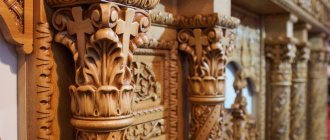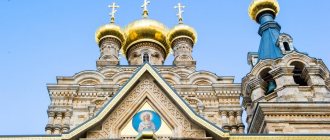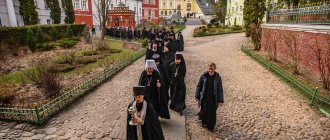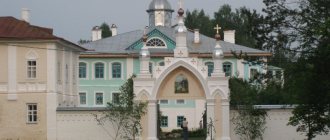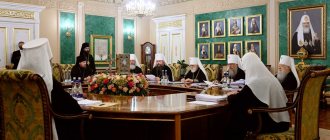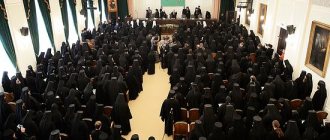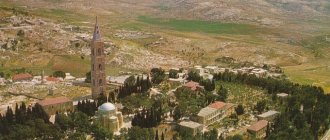St. Michael Athos Hermitage
St. Michael the Athos Hermitage is a monastery in Russia, belonging to the Maykop diocese of the Russian Orthodox Church. It is located in the village of Pobeda in Adygea. The monastery building is included in the list of architectural monuments.
The history of the monastery began in 1877, when a plot of land was allocated on the slope of Mount Fisiablo for the construction of an Orthodox monastery. The construction process was led by Hieromonk Martyry. All work was carried out through voluntary donations.
By 1883, five churches had been built in the monastery, and a priceless shrine was handed over - a piece of the Life-giving Cross of the Lord. Martyrius had already been elevated to the rank of archimandrite, and 180 inhabitants lived in the monastery.
By 1917, the monastery received up to 150 thousand pilgrims a year. But in 1920, the lands and all property of the monastery were confiscated. The monastery was closed, and on its territory there was a rest home, then a children's colony, and later a tourist center.
In 2001, part of the buildings was again transferred to the Russian Orthodox Church, and in 2002 the holy spring was revived. But a significant part was still occupied by the camp site. Only by 2003 were all the buildings returned to the monastery and restoration work began.
Today, life in the monastery has been completely revived. The territory has been landscaped, old buildings have been restored, and new facilities have been opened. With funds raised from visits by tourists and pilgrims, work continues to restore the Assumption Cathedral, which was blown up in 1947.
End of the day
How hardworking and inventive were the monks who inhabited the monastery in those distant times. Apples, pears, peaches and apricots ripened in their gardens. Even tangerines, lemons and oranges, which were a novelty for these places in those years. A variety of vegetables grew in the gardens. The fields were full of grain crops. They had their own apiaries, a stud farm, and various craft workshops. Let us wish that the modern inhabitants of the monastery will revive and increase the achievements of their ancestors.
The day came to an end, tired and full of impressions we reached Kyndyga. Along the way we continued to admire what we saw. And now I was telling you about New Athos, mentally returning to the wonderful world.
Write your thoughts about what you read in the comments. I would be grateful if you share this story on your pages on social networks. The drawing for a laptop for reposting articles takes place on the 1st of every month. May you be lucky!
See you again! Your Faith.
Alexander Oshevensky Monastery
Among the monasteries in Russia, the Alexander-Oshevensky Monastery of the Plisetsk diocese of the Russian Orthodox Church, located in the village of Pogost in the Arkhangelsk region, also attracts attention.
The monastery was founded by the Monk Alexander Oshevensky in the 1460s. After the first temple was erected, the founder died, and the monastery began to decline. The monastery was empty, only five elderly monks remained here.
The situation changed in 1488. The son of a local priest, Maxim, became the new abbot of the monastery. Thanks to him, the monastery's land holdings increased, another temple was erected, and the number of brethren increased. But after 1531, difficult times came again. The monks had to conduct land disputes with the peasants, and there were repeated arson attacks.
In 1706 there was a large-scale fire. After him, the monks began large-scale construction and restoration work. The monastery acquired its own livestock, lands, and fisheries.
The monastery ceased to exist in 1928, was looted and turned into ruins. At the moment, the monastery is at the initial stage of restoration and is in dire need of funds from the state and patrons.
Kirillo-Belozersky Monastery
In the list of monasteries in Russia, a special place is occupied by the Kirillo-Belozersky Monastery, located in the city of Kirillov, Vologda region. The monastery is located right on the shore of Lake Siverskoye. This is the spiritual center of the Russian North, one of the largest monasteries in the country.
The history of the monastery began in 1397. Its founder is Kirill Belozersky, a follower of Sergius of Radonezh. He dug a cave on the shore of the lake. Later, Ferapont Belozersky founded a monastery nearby. Later, a whole network of monasteries grew around this place.
At one time, the monastery became not just a major spiritual, but also an economic center. Trade routes crossed through it, and the monastery itself traded in fish and salt for a long time. The monastery was also the most important book center in the country. Even despite the major fire of 1557, the monastery did not lose its status as the largest and richest in the Russian North.
In 1918, the abbot was shot, and the monastery was abolished and ruined. In 1924, a museum-reserve was opened here, thanks to which historical monuments were preserved. After the war, restoration activities were launched. In 1998, the monastery was transferred to the Russian Orthodox Church. Today, one of the oldest monasteries in Russia has been almost completely restored and is operational.
Dam and hydroelectric power station
At the monastery in a deep gorge on one of the mountain ledges along which the waters of the Psyrtskha River flow, the monks built a waterfall in 1880. The grandiose structure was initially intended only for aesthetic pleasure. The sound of falling water, splashes shimmering with all the colors of the rainbow - the energy of life, the joy of being.
In 1888, Emperor Alexander III walked along an alley lined with cypress trees, starting in the mountainous part of the monastery and ending near the waterfall, with his wife Maria Feodorovna and 12-year-old son Nicholas after visiting the monastery. They are long gone, but the waterfall is just as beautiful and powerful.
In 1901, the monks built a hydroelectric power station next to the waterfall and from that time on the monastery began to be illuminated by electricity. Surely the hydroelectric power station, which is currently inactive, will be restored and it will begin to work, generating electricity. May be.
We climbed onto huge stone slabs that fenced off the storage lake from the cliff. When you stand on these slabs and observe the contrast between the almost motionless surface of the lake and the falling wall of furious water, an analogy with our life comes to mind, sometimes seething with events, sometimes calm. Along the path winding along the shore, you can reach an ancient gazebo, go into it and admire the surrounding splendor, standing above the water.
Valaam Spaso-Preobrazhensky Monastery
One of the most famous active male Orthodox monasteries in Russia is the Valaam Transfiguration Monastery. Once upon a time there was a temple here, then a monastery, and later a state farm. The monastery was destroyed and looted. Also during the Soviet era, the Home for the Invalids operated here. Since September 1989, the monastery was transferred to the use of the Leningrad diocese. Restoration work continues to this day.
You can get to Valaam by air or water. The monastery is open to pilgrims, but you cannot wander around the island on your own. Visitors are divided into groups and excursions are organized for them. There is a hotel designed for 200 pilgrims.
This is one of the most visited monasteries in Russia. Up to 100 thousand pilgrims and tourists come to the active male Orthodox monastery annually during the three summer months. But the abbots of the monastery propose to limit visits according to the model of the Athos monasteries. You will need to receive a written blessing in advance.
Savvino-Storozhevsky Monastery
The Savvino-Storozhevskaya monastery is another Orthodox monastery in Russia. It was founded in 1389 by the monk Savva, who was a student of Sergius of Radonezh, on Mount Storozhi. This place is considered one of the most beautiful in the Moscow region. Initially, the Monk Savva lived in the Trinity-Sergius Monastery. But at the request of Prince Dmitry Donskoy, he left his monastery and founded a new one near Zvenigorod. He became the abbot of this monastery.
But Savva himself did not live in the monastery. To hide from the worldly glory around his name and monastery, he built himself a cave in a ravine in the middle of a dense forest. Now on this site there is a monastery and a holy spring with a bathhouse. This is precisely the main goal of pilgrims. And on the territory of the monastery there is a historical and art museum.
Seaside or Swan Park
And the Psyrtskha River, having fallen from the height of the dam, carries its waters further. Along the way, another transformation awaits her. Monks built a complex system of canals in the 1880s. Some of them drain the river’s waters into the sea, while others are connected to seven artificial ponds. Water flows into the outermost pond, flows into the second, then into the third, etc. From the latter it goes to sea. Constant change of water.
The monks lined the walls and bottom of the ponds with stone tiles. The depth of the ponds does not exceed one and a half meters. Initially, these reservoirs were intended for fish breeding. The brothers raised carp, crucian carp and trout here for food.
Then, pedestrian paths were laid with slabs around the ponds, various types of trees were planted, and flower beds were laid out. They built arched bridges and placed benches for rest. In 1910, before the arrival of the royal family, the park was opened to the public.
Nowadays there are no fish in ponds. New residents appeared here - white and black swans. The majestic birds attract the attention of numerous visitors with their grace. People feed the birds, throw pieces of bread into the water, take photographs, take selfies against a beautiful background.
We wandered around the park. I noticed, under the shadow of the branches that sank to the very surface of the water, a family pair of black swans. They communicated with each other, pinching each other's feathers. I was touched, but the two little cubs caused even more emotions. They hid behind their parents and stretched out their thin necks funny, probably asking them for a treat.
Perhaps it's time for us to eat. The Swan Lake cafe was discovered in the park. Amazing! A meal overlooking the mirror-like surface of the water, along which graceful swans glide... The quality of the dishes pleased me and the prices did not scare me. The waiters are friendly and fast. Lunch was a success!
Pskov-Pechersky Monastery
Among the operating monasteries in Russia, one of the largest and most famous is the Holy Dormition Pskov-Pechersk Monastery. It all started with a cave church, which was consecrated in 1473. The first 500 years of the monastery's existence were very turbulent. But then, when Abbot Dorotheos became rector, a period of prosperity began. The monastery was landscaped and expanded, for which funds from donations were generously spent. The next period of prosperity began with the arrival of Abbot Cornelius. Under him, the monastery gained maximum popularity; a huge number of pilgrims flocked here.
Unlike other monasteries, this one never ceased to exist. Although after the revolution, monks and parishioners were persecuted, and during the war many buildings were damaged. To date, the monastery has been almost completely restored and is operational. The monastery carries not only spiritual, but also enormous cultural value.
Healing ringing of bells
Before, during and after each service, a magical bell ringing is heard from the monastery throughout the entire area. Bells of different sizes hang on the belfry near the monastery garden. The bell ringer Dmitry comes up to them, reads a prayer and begins to ring the small bells first, then connects the middle ones, and now the entire belfry sounds like a single instrument. Dmitry deftly pulls the ropes, presses the pedal with his foot, and sweet, ringing, real music flows from the belfry.
Dmitry, a former entrepreneur, works at the monastery as both a fireman and an electrician, and is also involved in other economic affairs. I couldn’t even imagine that he would be a bell ringer two years ago.
- We are sitting in the refectory, there is no bell ringer, the father of the brothers asks: “Who wants to ring?” Well, several brothers are raising their hands. And he came to me: “Brother Dmitry, do you want to call?” I say: “Father, have mercy, what kind of bell-ringer am I?” And the priest says: “Dmitry, you want to call,” Dmitry recalls, chuckling. “I went to the belfry, hung here on the bells, I don’t know what to do, I said: “Lord, help me!” And the Lord helped and taught me. This is a monastery. These things happen here! I had no idea about a lot of things, but you just have to receive the blessing and everything works out. Previously, I didn’t know how to fix an outlet, but I lived here and now I can cover the whole house with wires.
Even before my trip to the monastery, I heard a myth that bell ringers never get sick with cancer or vascular diseases. And Dmitry confirmed this.
– If you pour water on a drum and hit it, what will happen to the water? She will crumble into dust. Human skin is a drum turned inside out. He touched the bell - and all the blood that runs through the vessels explodes inside, liquefies, all blood clots and clots go away. The circulatory system begins to work well, oxygen enrichment occurs,” says the bell ringer. – There are so many sounds in one ringing of a bell! If you write it down and break it down into ranges, you get three or four octaves. From the bell you receive so many frequencies that everything harmful in the body is broken down. Bells are alive, their ringing heals the body and soul. But the main thing is that the bells glorify God and remind the world that He exists.
Trinity-Sergius Lavra
The Trinity-Sergius Lavra is one of the largest monasteries in Russia. It is located in Sergiev Posad, Moscow region. This is not just a monastery, but also a large educational and publishing center. The theological academy is located here.
The founding date of the monastery is considered to be 1337, when Sergius of Radonezh settled on Makovets Hill. After several years of solitary asceticism, inhabitants began to flock here, and the hermitage turned into a monastery.
In the Middle Ages, the monastery played an important political role, being a support for both the people and the authorities. The monks fought against the Tatar-Mongol yoke, opposed False Dmitry and the Seven Boyars, and the Polish-Lithuanian troops.
The heyday of the monastery is associated with the reign of Elizabeth Petrovna. She founded a theological seminary and theological academy here. She endowed the monastery with the title of Lavra.
In 1918, the monastery was transformed into a labor artel. Later, electrical engineering courses, hospitals, schools, children's institutions, and museums appeared here. Many buildings were converted for residential and commercial needs. Only in the post-war period did restoration work gradually begin.
Today, most of the buildings have been restored to their original appearance (wall painting, roofing, paintings, bells). The brethren number about 200 monks. The architectural ensemble of the Lavra is included in the UNESCO heritage list.
Ascension David's Hermitage
The list of male monasteries in Russia continues with the Ascension David's Hermitage. It is located on the banks of the Lopasni River in the Chekhov district of the Moscow region. The monastery was founded back in 1515 by the Monk David. Near the monastery he planted a linden grove.
In 1619, the monastery was destroyed by the troops of Hetman Sagaidachny. After another 10 years, the desert was excluded from the New Jerusalem list. In the 17th century there came an unprecedented prosperity, which after 100 years was replaced by a decline associated with Peter’s reforms. In Soviet times, the monastery was closed and the brethren were repressed.
The modern history of the monastery began in 1992, when residents of the village of Novy Byt formed an Orthodox community. Today, pilgrims come here to venerate the holy particles of relics, of which there are more than 200 in the monastery.
The main shrines of the monastery of St. Alexander of Svirsky
Place of the appearance of the Mother of God to Saint Alexander of Svirsky
Located in the Church of the Intercession of the Mother of God, built by Alexander Svirsky in 1533. The Mother of God appeared here to the saint and promised that “Her beneficial cover will not become scarce over this monastery.”
Place of the appearance of the Holy Trinity to Saint Alexander of Svirsky
Located in the Cathedral of the Holy Trinity. It was built in 1791 on the site of a wooden church, from which the history of the monastery began.
Relics of Alexander Svirsky
They rest in the Transfiguration Cathedral (1640–1644).
Krypetsky St. John the Theologian Monastery
The list of active monasteries in Russia continues with the Krypetsky St. John the Theological Monastery. It belongs to the Pskov diocese and is located near the village of Krypetsky in the Pskov region. The monastery was founded in 1455 by a native of Serbia, Savva Krypetsky. Prince Obolensky took an active part in the construction of the monastery.
By the end of the 17th century, the monastery experienced many favorable and unfavorable periods, but in the end it became impoverished. Although, by the twentieth century he again became the richest in Russia. After the Revolution, the monastery was closed. All valuables were taken away, many were irretrievably lost. For a long time there was a cattle yard on the territory of the monastery.
In 1960, the monastery was declared a monument of republican significance, and in 1990 it was transferred to the Russian Orthodox Church. Today, the monastery has been restored and new facilities have been built. It is home to 40 monks and novices, as well as more than 50 workers.
How to become a monk
At the moment, there are many monasteries in Russia where new novices are accepted. But it's not as simple as it might seem in reality. Before you enter the monastery, you will have to go through something of a probationary period to prove your good intentions (both to the abbot of the monastery and to yourself). It implies the following:
- Regular visits to the temple. You must regularly attend services, confess, receive communion, and observe all fasts. It is also important to talk with the priest about your intention.
- Staying in a monastery as a worker. The monks not only pray, but also work in the monastery. This is hard physical work. As a rule, workers stay in the monastery for two to three weeks a year.
- Promotion to novices. If after being a laborer you have not changed your intentions, then you must write a petition to become a novice. At the same time, you will bear a worldly name.
- Taking monastic vows. Those who have passed the probationary period become monks and begin to live in the monastery, spending time working and praying.
Please note that people over 30 years of age are more readily accepted as monks. Reasons for refusal may include the presence of dependents, large debts, as well as recent severe stress.
Answers to the scanword of the day from Odnoklassniki number 22429
22428 22430
- Monastery for monks from 5 letters: LAURA
- Iraqi port with 5 letters: BASRA
- “Sea” cockade of 4 letters: CRAB
- "Challenger" as a ship with 5 letters: SHUTTLE
- Weed suitable for livestock feed with 4 letters: SOOT
- Schmidt, Bismarck and Stirlitz (name) from 4 letters: OTTO
- Tank caterpillar part with 4 letters: TRUCK
- Port city in Japan with 4 letters: OITA
- 4 letter fortune teller deck: TAROT
- in the photo from 6 letters: KUTORA
- Suitable Russian guy's name with 4 letters: LUKA
- 4 letter tennis stroke: SMASH
- Russian 5 letter unit of length: ARSHIN
- Director Muratova from 4 letters: KIRA
- in the photo from 6 letters: ANORAK
- Gin's 5-letter partner: TONIC
- 6 letter wall poster: POSTER
- The device at the heart of the autopilot consists of 8 letters: GYROSCOPE
- 6-letter evaluation criterion: MEASUREMENT
- State of Puerto... from 4 letters: RICO
- Ship's tackle from 4 letters: STAG
- People in Ethiopia with 5 letters: OROMO
- 4 letter bandage tape: BANDAGE
- Choir of singers in a 6-letter church: KLIROS
- Which city did Hector defend? 4 letter: TROY
- 8 letter road surface: APOKONIN
- Thin marker of 5 letters: LINER
- Pier pile with 6 letters: FUN
- in the photo from 6 letters: BASHLYK
- in the photo from 7 letters: BUG
- Discount from the assigned price of 7 letters: CONDITION
- 4 letter anagram for the word “kila”: LAKI
- Switches to Fedot from 5 letters: HICCUP
comments, questions and answers to the crossword puzzle of the day:
LAURA w. The name of some large privileged Orthodox monasteries under the direct jurisdiction of the Synod.
CRAB m. 1. Marine invertebrate animal of the order of decapod crustaceans; short-tailed crayfish. 2. transfer decomposition The emblem on the sailors' uniform cap.
SOOT m. Large weedy herbaceous plant of the Asteraceae family.
TRUCK m. Caterpillar link of a tractor, tank, all-terrain vehicle.
KUTORA w. A small mammal of the shrew family that lives along the banks of rivers and lakes.
LUKA w. 1. Arc-shaped turn of the river. // decomposition bending something 2. Bending of the front or rear edge of the saddle.
ARSHIN m. 1. A measure of length equal to 0.711 m and used before the introduction of the metric system in Russia and a number of other countries. 2. A ruler of this length with divisions into quarters and vertices marked on it.
TONIC m. 1. A tonic in the form of a drink or a specially prepared medicine. 2. Toning cosmetic product.
POSTER [1] m. 1. An artistic drawing accompanied by a short text that is organically related to the image and calls for certain actions. 2. A sheet of paper, a strip of fabric, etc. with an appeal, a slogan. // An advertisement written on smth.
POSTER [2] no longer available 1. Passport issued to peasants and petty bourgeois (in the Russian state until 1917).
GYROSCOPE m. A freely suspended, rapidly rotating body (a top), the axis of rotation of which can change its position in space, but thanks to its rapid rotation, maintains a constant direction for any changes in the position of the suspension.
MEASUREMENT Wed. decomposition 1. Something that is used to measure something. 2. That which serves as the basis for evaluating, measuring something. or comparison with something; criterion.
STAY m. A rope from the top of the mast or topmast to the bow, keeping the mast from falling.
BANDAGE m. Tape made of gauze or something. other fabric for medical dressings.
KLIROS m. 1. Place for singers in a Christian church (on a raised platform in front of the altar on the right and left sides of the royal doors). 2. The singers themselves, singing in such a place; church choir
JOKE m. 1. Action according to meaning. verb: to pin, to pin. 2. Pile, stake driven into the ground (for mooring ships, tying animals, etc.).
BASHLYK m. A cloth or woolen cape in the form of a hood with long ends, usually worn over a hat.
BUG [1] f. A small insect, a small bug.
BUG [2] m. and f. decomposition Inconspicuous, small person.
CONDITION w. 1. Action according to value. verb: to give in, to give in. 2. Refusing something. for the benefit or benefit of someone; agreement, compromise. 3. decompression Discount from the stated price.
LUCKY pl. see laks.
HICCUP w. Involuntary short breaths, accompanied by abrupt sounds, caused by convulsive contraction of the diaphragm.

